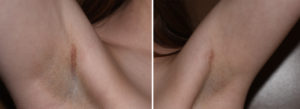Background: One of the considerations in breast augmentation surgery is the choice of the incision. While it is important to remember that the incision is just a method of access to the making of the desired breast pocket, and what is done on the inside remains the same regardless of the incision used, it is big preoperative focus for many patients. That choice can also affect certain other aspects of the breast implant operation.
One incisional option is that of placing it in the armpit, known as the trasnaxillary breast augmentation approach. On the surface it offers the obvious advantage of being ‘scarless’ at least from a breast standpoint. It is also a scar location that heals exceptionally well as it is placed in the moist and thinner hair bearing skin of the axilla.
But it has advantages as well. It offers the most direct approach to getting into the submuscular plane for making the implant pocket. The axillary incision is directly right under the thickest part of the pectorals major muscle being just a few centimeters away. Once into the pocket the entire submuscular pocket can be easily elevated to all corners of the breast to make a good implant pocket. The only disruption of really firm tissue attachments that are needed is laterally beyond the edge of the muscle. This is the reason bruising often occurs in this chest wall area after surgery.
Case Study: This young female wanted to improve her breast size by a modest amount. She was a small B and wanted to be either a full B cup or a small C cup.


Highlights:
1) The use of saline breast implants is the origin of the transaxillary breast augmentation incisional approach.
2) It is a blunt submuscular dissection approach that offers the shortest operative time .
3) While it causes the most swelling immediately after surgery, it also offers the quickest recovery time.
Dr. Barry Eppley
Indianapolis, Indiana




